We may not have the course you’re looking for. If you enquire or give us a call on +31 208081674 and speak to our training experts, we may still be able to help with your training requirements.
Training Outcomes Within Your Budget!
We ensure quality, budget-alignment, and timely delivery by our expert instructors.
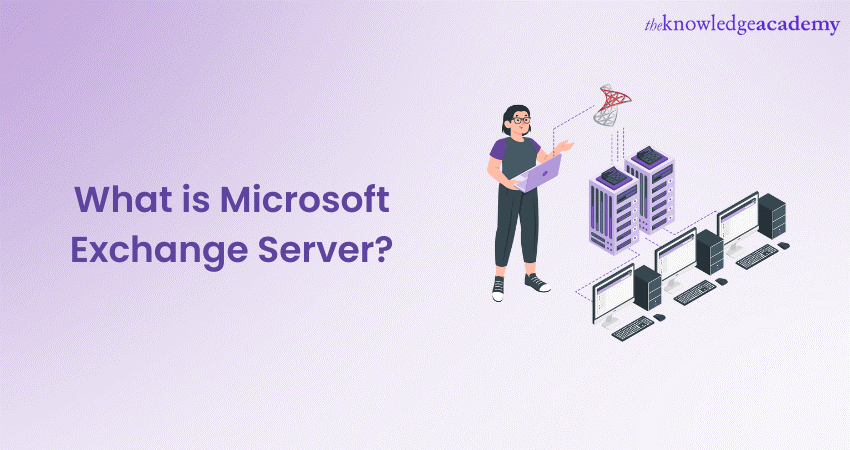
What is Microsoft Exchange Server? It is a powerful email, calendar, and contacts solution developed by Microsoft, primarily aimed at businesses and enterprise-level organisations. This server software facilitates secure and efficient internal and external communication, offering features like email archiving, task management, and customised scheduling options.
According to Statista, in 2022, approximately 76% of Microsoft Exchange Server users around the globe used cloud-based Exchange mailboxes. It integrates seamlessly with other Microsoft products, such as Outlook and SharePoint, to create a unified communication environment. Read this blog to learn What is Microsoft Exchange Server, its three key aspects, and understand how it works.
Table of Contents
1) What is Microsoft Exchange Server?
2) The three key aspects of Microsoft Exchange Server
a) Connectivity
b) Authentication
c) Security
3) How Microsoft Exchange Server works?
a) Clients for the Exchange Server
b) Interoperability between servers
c) Implementation of Exchange Server
d) Calculating the processing speed
e) Processor capabilities
f) Troubleshooting connectivity
4) Conclusion
What is Microsoft Exchange Server?
Microsoft Exchange Server is a collaboration and messaging solution developed by Microsoft, designed to manage various forms of digital communication within an organisation. Predominantly utilised for email management, it also offers features for calendars, contacts, and tasks, all coordinated from a central location.
Additionally, Microsoft Exchange Server functions primarily on Windows Server operating systems, allowing businesses to control their internal communication rather than relying on third-party services. This can be vital for maintaining security, compliance, and efficient organisational workflow.
One of its key advantages is seamless integration with other Microsoft products, such as Outlook, providing users with a unified experience across various platforms. Whether in the office or working remotely, users can access their emails, appointments, and relevant documents, thus enhancing productivity and collaboration.
Microsoft Exchange Server offers flexibility in deployment options, including on-premises, cloud, or a hybrid model, catering to different organisational needs and preferences. It continues to evolve with constant updates and newer versions, providing users with the latest tools and security measures. It has become an indispensable asset for many businesses, streamlining communication and collaboration.
The three key aspects of Microsoft Exchange Server
Microsoft Exchange Server is a Microsoft-developed server used for managing mail and calendars, essential for business communication. It offers seamless integration with collaboration tools, providing robust email solutions, calendar integration, and compatibility with various protocols. Deployment flexibility and enhanced security features make it a preferred choice for organisations of all sizes. The following are its three key aspects:
Connectivity
Microsoft Exchange Server excels in connectivity, ensuring streamlined communication within an organisation. It supports various protocols like Internet Message Access Protocol or IMAP, Simple Mail Transfer Protocol or SMTP, and Post Office Protocol or POP, facilitating compatibility with different email clients and systems. This broad range of supported protocols ensures that users have access to their emails, calendars, and contacts through various platforms, including mobile devices.
Additionally, the server's connectivity extends to integrating with Microsoft products like Outlook. This offers a cohesive and efficient communication environment, allowing users to manage their emails, appointments, and tasks from a single interface, whether in the office or remotely.
Furthermore, the Exchange Server's connectivity enables Hybrid deployment, combining on-premises and cloud-based services. This ensures a seamless transition and interoperation between different platforms, catering to various organisations' unique needs and preferences.
Moreover, the connectivity aspect of Microsoft Exchange Server promotes collaboration among team members. Shared mailboxes, calendars, and task management features enable real-time coordination and communication, enhancing productivity within a team or across the entire organisation.
Authentication
Authenticity in Microsoft Exchange Server is pivotal to ensuring the integrity and reliability of communication within an organisation. In this context, authenticity refers to the various security measures implemented to verify users' identity and content legitimacy.
Microsoft Exchange Server utilises authentication protocols such as Kerberos, NTLM, and OAuth, confirming the identity of users accessing the system. This ensures that only authorised individuals can access sensitive information, maintaining confidentiality.
Furthermore, the server supports Transport Layer Security (TLS) to encrypt communication between the server and client devices. This encryption assures the transmitted data's authenticity, ensuring that the information has not been altered or tampered with during transmission.
Additionally, the server's integration with anti-malware and anti-spam filters adds another layer of authenticity. Scanning incoming and outgoing emails for suspicious content ensures that only legitimate messages are delivered.
Moreover, Role-based Access Control (RBAC) can be configured, allowing administrators to assign specific permissions to different users. This granular control over user access further underscores authenticity by letting only authorised individuals perform particular tasks.
Manage your recipients and bulk operations, by signing up for the Administering Microsoft Exchange Server 2016/2019 M20345-1 course now!
Security
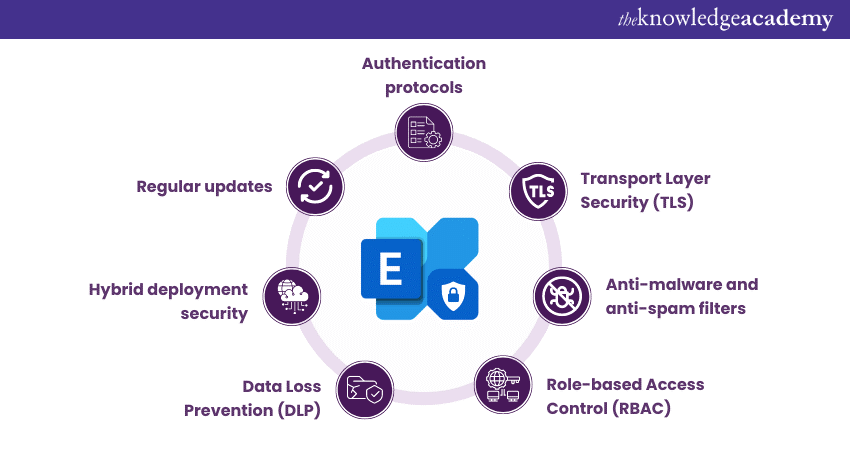
The security aspect of Microsoft Exchange Server is vital for safeguarding information and ensuring a resilient communication platform. Here's
a) Authentication protocols: Using authentication protocols like Kerberos and OAuth, Microsoft Exchange Server ensures that only authorised individuals can access specific information. This keeps sensitive data secure from potential breaches.
b) Transport Layer Security (TLS): TLS encrypts emails during transit, preventing unauthorised interception and tampering. Whether the email is within the organisation or sent externally, TLS ensures that the communication remains private and intact.
c) Anti-malware and anti-spam filters: Integrated anti-malware and anti-spam filters routinely scan incoming and outgoing emails, blocking suspicious content and protecting users from malicious threats.
d) Role-based Access Control (RBAC): Administrators can assign permissions based on roles, controlling access to various functions within the Exchange Server. This ensures that only qualified individuals have the authority to perform specific tasks, reinforcing security.
e) Data Loss Prevention (DLP): Microsoft Exchange Server's DLP features prevent the accidental or intentional leakage of sensitive information. It monitors and controls data transmission by defining rules and policies safeguarding valuable organisational information.
f) Hybrid deployment security: Even in hybrid environments where Exchange Server is linked with cloud services, consistent security policies can be maintained, providing a seamless and secure experience across various platforms.
g) Regular updates: Microsoft continually releases security updates to address vulnerabilities and enhance protection. Regular updates keep the server aligned with the latest security standards.
How Microsoft Exchange Server works?
Microsoft Exchange Server is a central hub for email, calendaring, and collaboration within an organisation. It operates on Windows Server operating systems, supporting protocols like IMAP, SMTP, and POP. Its integration with tools like Outlook and robust security measures ensures seamless and secure communication across various platforms. Here are the key elements behind its operability:
Clients for the Exchange Server
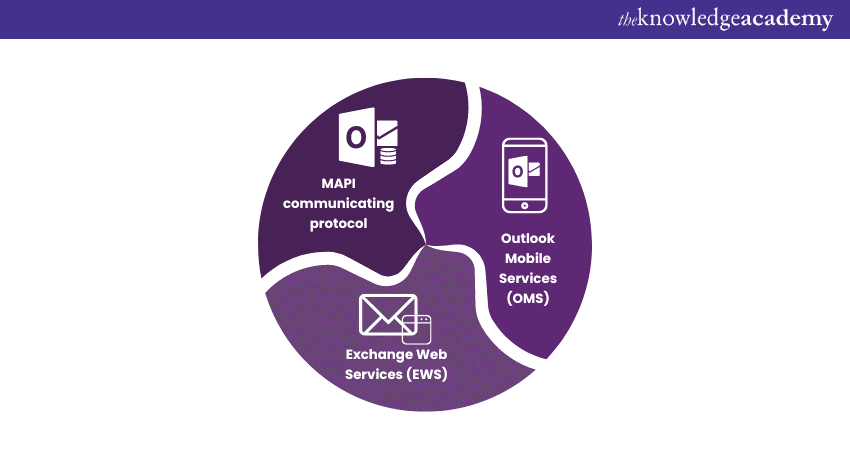
Microsoft Exchange Server works with different clients to facilitate seamless communication and collaboration. Below are descriptions of three major components involved:
a) Messaging Application Programming Interface (MAPI) communicating protocol: The MAPI is a crucial protocol used by Microsoft Exchange Server to communicate with email clients like Microsoft Outlook.
Additionally, MAPI allows email clients to send and receive messages, manage folders, and perform other tasks related to email and calendars. It enables a rich and interactive email experience by allowing clients to work online and offline. Security measures can be integrated within MAPI to ensure secure communication.
b) Exchange Web Services (EWS): Exchange Web Services is a modern protocol that facilitates access to information within an Exchange server. EWS enables the development of web applications to access an Exchange mailbox.
This includes reading, creating, and managing items, folders, and attachments. It provides a flexible and efficient way to integrate Exchange features into various applications, enhancing functionality and accessibility. EWS allows users to enjoy a consistent experience across different platforms and devices.
c) Outlook Mobile Services (OMS): Outlook Mobile Services is a feature that enables sending and receiving text messages (SMS) and Multimedia Messaging Service (MMS) in Microsoft Outlook. Integrated with Microsoft Exchange Server, OMS allows users to manage text messages just like emails.
Furthermore, users can send, receive, and even schedule text messages using their existing email client. OMS extends the capabilities of Outlook and Exchange to mobile communication, bridging the gap between email and mobile messaging.
Interoperability between servers
Interoperability between servers is vital to modern IT infrastructure, allowing different systems, applications, and platforms to work together seamlessly. In the context of Microsoft Exchange Server, this interoperability can be explored in several ways:
a) Protocol support: The Exchange Server supports various standard protocols like IMAP, SMTP, and POP. This ensures compatibility with a wide range of email clients and other servers, facilitating cross-platform communication and data exchange.
b) Integration with other Microsoft products: The tight integration between Exchange Server and other Microsoft products like SharePoint, Outlook, and Office 365 provides a cohesive user experience. These integrations enable smooth data flow and feature accessibility across various applications.
c) Hybrid deployments: Exchange Server’s ability to function in hybrid environments, which can work simultaneously with on-premises and cloud-based platforms, showcases interoperability. This allows for a smooth transition between systems, retaining user experience and security consistency.
d) Third-party integrations: Exchange Server’s compatibility with third-party applications, tools, and systems extends its interoperability beyond the Microsoft ecosystem. It can communicate and work in tandem with various other platforms through APIs and connectors.
e) Standard compliance: By adhering to industry standards and compliance requirements, Exchange Server ensures that it can interact with other systems while maintaining regulatory norms. This is essential for industries with strict legal and regulatory considerations.
f) Data migration and conversion: The Exchange Server supports various data migration and conversion tools, enabling the transfer of information between different systems and formats. This facilitates upgrades, migrations, or integration with other systems without data loss.
Design and deploy your server, by signing up for the Designing and Deploying Microsoft Exchange Server 2016/2019 M20345-2 course now!
Implementation of Exchange Server
Implementing Microsoft Exchange Server within an organisation involves several critical steps and considerations. Here's a point-by-point overview of the process:
a) Assessment: Evaluate the existing IT infrastructure, requirements, and objectives to determine the best deployment option, whether on-premises, cloud, or hybrid.
b) Planning: Create a detailed implementation plan, considering hardware requirements, network configuration, security protocols, and compliance needs.
c) Licensing: Select the appropriate licensing model based on the size and needs of the organisation.
d) Installation: Install the required Windows Server operating system, followed by the Exchange Server software, ensuring compatibility and adherence to prerequisites.
e) Configuration: Configure server roles, mailboxes, transport settings, and other essential elements in line with organisational requirements.
f) Integration: Integrate with existing applications like Outlook and SharePoint and set up protocols such as IMAP, SMTP, and POP as needed.
g) Security measures: Implement protocols like TLS, anti-spam, anti-malware, and role-based access controls to ensure robust protection.
h) Migration: If upgrading from a previous version or another platform, plan and execute data migration to transfer existing information.
i) Testing: Conduct thorough testing to ensure functionality, performance, and security align with expectations.
j) Training: Provide necessary training and support to IT staff and end-users to facilitate smooth adoption and usage.
k) Monitoring and maintenance: Implement monitoring tools and regular maintenance schedules to ensure optimal performance and timely updates.
l) Disaster recovery: Establish backup and disaster recovery plans to mitigate potential data loss or system failures.
m) Documentation: Maintain comprehensive documentation of configurations, policies, and procedures to support future troubleshooting or modifications.
n) Compliance: Ensure alignment with legal and regulatory standards specific to the industry or region.
Calculating the processing speed
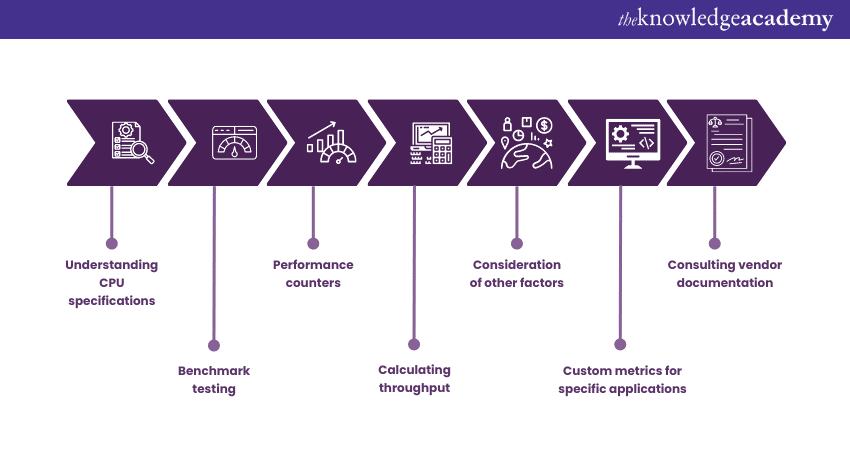
Calculating the processing speed of a system, such as Microsoft Exchange Server, is vital for understanding its performance capabilities. Processing speed is often measured in instructions per second or cycles per second, and here's how it's generally calculated:
a) Understanding CPU specifications: Look at the CPU's clock speed, usually measured in Gigahertz (GHz), which indicates how many cycles the CPU can perform per second. Consider also the number of cores, as multi-core processors can execute multiple instructions simultaneously.
b) Benchmark testing: Utilise benchmarking tools that simulate various tasks to assess how quickly the processor can execute them. This gives a practical measurement of processing speed in real-world scenarios.
c) Performance counters: Tools like Performance Monitor on Windows can provide insights into CPU usage and performance. This allows tracking of how efficiently the CPU handles tasks over time.
d) Calculating throughput: Assess how many tasks or instructions are processed in a given time frame. This might include measuring tasks like email processing in the context of Exchange Server.
e) Consideration of other factors: Remember that processing speed isn't just about CPU performance. RAM, storage speed, network latency, and software configuration can all impact the effective processing speed.
f) Custom metrics for specific applications: In the context of a specific application like Microsoft Exchange Server, you might create custom metrics to understand how quickly it can process particular tasks, such as handling emails, synchronising calendars, etc.
g) Consulting vendor documentation: Software or hardware vendors sometimes provide specific tools or guidelines for calculating processing speed tailored to their products.
Processor capabilities
A processor's capabilities define its performance and efficiency in handling tasks within a system. Here's an overview of these capabilities:
a) Clock speed: The clock speed determines how many cycles a processor can execute per second. A higher clock speed typically translates to faster processing.
b) Multi-core technology: Modern processors often contain multiple cores that can execute several instructions simultaneously. This parallel processing boosts multitasking and overall performance.
c) Cache memory: Processors have built-in cache memory, which stores frequently accessed data and instructions. A larger cache improves efficiency by reducing the time taken to fetch data from the main memory.
d) Instruction Set Architecture (ISA): The ISA defines the collection of instructions that the processor can execute, determining its compatibility with software and operating systems.
e) Power efficiency: Advanced processors manage power consumption effectively, delivering performance when needed and conserving energy when demand is low.
f) Integrated graphics: Some processors are designed with integrated graphics capabilities, enabling decent graphics performance without a separate graphics card.
g) Virtualisation support: Many processors now support virtualisation, allowing multiple virtual systems to operate on a single physical machine.
h) Security features: Processors may include hardware-based security features that enhance protection against malware and cyber-attacks.
Learn to create and install virtual machines, by signing up for the Introduction to Virtualisation Technologies course now!
Troubleshooting connectivity
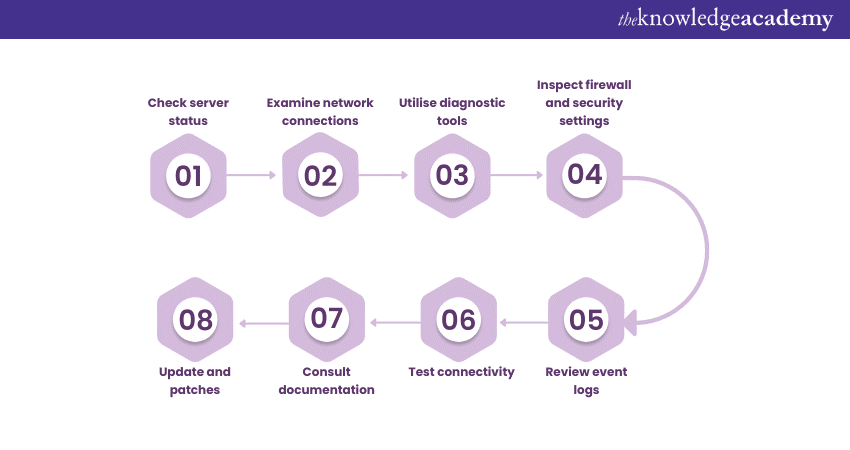
Troubleshooting connectivity issues on Microsoft Exchange Server requires a systematic approach to identify and resolve the problem. Here are the main steps explained briefly as follows:
a) Check server status: Ensure the Exchange Server and related services are running. Restart them if necessary.
b) Examine network connections: Verify that network cables, switches, and routers are functioning properly. Check the server's network settings for correct configuration.
c) Utilise diagnostic tools: Tools like the Exchange Troubleshooting Assistant can provide insights into specific issues and recommend solutions.
b Inspect firewall and security settings: Incorrect firewall rules or security configurations can block necessary ports and protocols. Make sure that they are configured to allow Exchange traffic.
e) Review event logs: The Windows Event Viewer can reveal error messages and warnings related to connectivity. Analyse these logs for clues to the underlying issue.
f) Test connectivity: Use command-line tools like 'ping' and 'telnet' to test connectivity to the server and 'Test-Connection' cmdlet in Exchange Management Shell for more specific Exchange-related testing.
g) Consult documentation: Microsoft provides extensive documentation and community support. If the issue persists, consult these resources or contact Microsoft Support.
h) Update and patches: Ensure the server has the latest updates and security patches, as outdated software might lead to connectivity issues.
Conclusion
We hope you enjoyed reading this blog and understood What is Microsoft Exchange Server and how it is crucial for any organisation that looks to improve its communication and collaboration. From its functionality to implementation and troubleshooting, grasping these aspects ensures effective use of this robust platform. The software tool is a comprehensive solution catering to various business needs.
Monitor, maintain and troubleshoot your mail server, by signing up for the Microsoft Exchange Server Training now!
Frequently Asked Questions
Upcoming Microsoft Technical Resources Batches & Dates
Date
 Retired : Administering Microsoft Exchange Server 2016/2019 M20345-1
Retired : Administering Microsoft Exchange Server 2016/2019 M20345-1
Mon 13th Jan 2025
Mon 17th Feb 2025
Mon 18th Aug 2025







 Top Rated Course
Top Rated Course



 If you wish to make any changes to your course, please
If you wish to make any changes to your course, please


